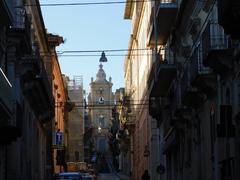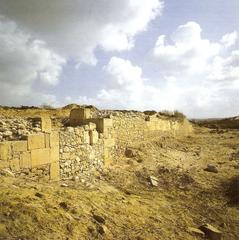Ragusa Cathedral Visiting Hours, Tickets & Historical Sites Guide
Date: 15/06/2025
Introduction to Ragusa Cathedral
The Cathedral of San Giovanni Battista, commonly known as Ragusa Cathedral, is a crowning jewel of Sicilian Baroque architecture and one of the most significant landmarks in southeastern Sicily. Located in Ragusa Superiore, the cathedral not only serves as a place of worship but also embodies the region’s resilience and artistry following the devastating 1693 earthquake. Its grand marble façade, Corinthian columns, intricate stuccoes, and Latin cross interior are testament to a vibrant historical and cultural legacy. The cathedral continues to be a living center of community and faith, hosting important religious festivals such as the annual procession of St. John the Baptist on August 29th.
This guide delivers detailed and up-to-date information on Ragusa Cathedral’s visiting hours, ticketing, accessibility, and nearby historical sites, along with practical tips for visitors. Whether you’re an art lover, history buff, or spiritual traveler, the cathedral promises a memorable and enriching experience. For real-time updates and planning resources, consult the Cathedral’s official website and local tourism guides (Visit Italy).
Contents
- Introduction to Ragusa Cathedral
- Historical Overview
- Construction & Architectural Evolution
- Cultural & Religious Significance
- Visitor Information
- Visiting Hours
- Tickets & Admission
- Accessibility
- Guided Tours & Special Events
- Photography & Best Spots
- Nearby Attractions
- Urban & Architectural Context
- Frequently Asked Questions (FAQ)
- Summary & Visit Recommendations
- Sources & Further Reading
Historical Overview
Origins and Early History
The origins of Ragusa Cathedral are deeply intertwined with the city’s evolving identity. Before the earthquake of 1693, a church devoted to St. John the Baptist graced the older Ragusa Ibla, beneath the medieval castle. Centuries of Greek, Roman, Byzantine, Arab, Norman, and Spanish influence shaped Ragusa’s spiritual and cultural life.
The 1693 earthquake destroyed much of the Val di Noto, including the original cathedral. This disaster split Ragusa’s population: the aristocracy rebuilt in Ibla, while the burgeoning bourgeoisie established Ragusa Superiore. This urban shift led to the construction of two great cathedrals: San Giorgio in Ibla and San Giovanni Battista in Superiore.
Construction & Architectural Evolution
Initial Construction (1694–1705)
Ragusa Cathedral’s construction began in 1694, just a year after the earthquake, quickly establishing a new spiritual center for the city’s growing upper quarter. The main structure was completed in 1695, and the building was expanded between 1708 and 1719 to accommodate a larger congregation.
Baroque Transformation
An exemplar of Sicilian Baroque, the façade features five bays separated by Corinthian columns and adorned with statues of the Immaculate Conception, St. John the Evangelist, and St. John the Baptist. The central window, flanked by two sundials, is a distinctive element. The bell tower, rising 50 meters, was intended to be one of a pair, but the second was never built due to safety concerns.
Interior Decoration & Later Modifications
The cathedral’s Latin cross plan is marked by three broad naves, gilded Corinthian columns, and stuccoes by the Gianforma brothers. The geometric-patterned floor, completed in 1854, uses pitchstone and limestone. Artistic highlights include Sebastiano Conca’s “St. Philip Neri,” A. Manno’s “Christ at the Column,” and Carmelo Licitra’s early 19th-century wooden statue of St. John the Baptist, which is still carried in the annual August procession.
Cultural & Religious Significance
Ragusa Cathedral is the focal point of Ragusa Superiore’s spiritual life. It hosts major liturgical celebrations, processions, and community gatherings. The annual festival on August 29th honors St. John the Baptist, drawing locals and visitors alike. Since 1950, the cathedral has served as the seat of the Diocese of Ragusa and, in 2002, became part of the UNESCO-listed “Late Baroque Towns of the Val di Noto” (Visit Italy).
Visitor Information
Location & Access
- Address: Via Roma 134, 97100 Ragusa, Italy
- Piazza: The cathedral faces Piazza San Giovanni, a lively square with cafés and shops (official cathedral site).
Getting There
- By Car: Parking is available near Corso Italia and Via Roma; no dedicated cathedral parking.
- By Bus: Regional buses connect Ragusa with surrounding cities, with stops near Ragusa Superiore.
- By Air: The nearest airport is Comiso (approx. 20 km). Taxis and car rentals are available (Stories by Soumya).
Local Transport
Walking is the best way to explore Ragusa Superiore and reach the cathedral. Buses and taxis are available for visiting Ragusa Ibla and other sites.
Visiting Hours
- Regular Hours: 10:00 am – 12:30 pm & 4:00 pm – 6:00 pm daily.
- Extended hours may be available during festivals and events—always check the official cathedral website before your visit.
Tickets & Admission
- Cathedral entry: Free for all visitors (Modern Traveler; Stories by Soumya).
- Bell Tower: €2 fee to climb 129 steps for panoramic views (The Road Reel; Go Ask a Local). Not accessible to those with mobility issues.
Accessibility
- Step-free entrance on Corso Italia; the main nave is wheelchair and stroller accessible (cathedral official site).
- The bell tower is not accessible for visitors with mobility challenges.
Dress Code & Etiquette
- Modest attire required: shoulders and knees covered.
- Silence, especially during services, is appreciated.
- Photography allowed without flash; respect worshippers (Lotus Eaters Travel).
Guided Tours & Museum
- Guided tours are available through local tourist offices or by special arrangement.
- The cathedral’s small museum exhibits religious artifacts and art (Eternal Arrival).
Special Features & Experiences
Bell Tower Climb
A highlight for many, the 129-step climb rewards visitors with views across Ragusa and the valley beyond. Tickets are purchased at the entrance; the climb is moderately challenging (The Road Reel).
Organ & Music
The cathedral’s large organ is used for recitals and choral performances, which can add a special atmosphere to your visit (Lotus Eaters Travel).
Religious Services
Mass is celebrated daily. Service times are posted at the entrance and on the cathedral’s website. Attending a service offers a deeper spiritual experience.
Nearby Historical Sites & Attractions
- Ragusa Ibla: The city’s historic lower quarter, famed for its Baroque streets and the Church of San Giorgio (Uncovered Sicily).
- Palazzo Bertini: Notable for its grotesque Baroque masks.
- Church of Santa Maria delle Scale: Provides panoramic views and connects Superiore with Ibla.
Facilities & Amenities
- Restrooms: Available near Piazza San Giovanni.
- Shops: Religious and souvenir shops nearby.
- Cafés & Restaurants: Numerous options around the piazza (Lotus Eaters Travel).
- Wi-Fi: Not typically available inside; many cafés nearby offer access.
Best Times to Visit
- For fewer crowds: early morning or late afternoon.
- Pleasant weather: April–June and September–October (Stories by Soumya).
Safety & COVID-19
Ragusa is considered safe for travelers. As always, remain mindful of belongings. For the latest COVID-19 guidelines, consult the cathedral’s website or local authorities.
Frequently Asked Questions (FAQ)
Q: What are Ragusa Cathedral’s visiting hours?
A: 10:00 am – 12:30 pm and 4:00 pm – 6:00 pm daily; check the official site for updates.
Q: Is admission free?
A: Yes, with a €2 fee for the bell tower.
Q: Can I climb the bell tower?
A: Yes, via 129 steps; not suitable for those with mobility issues.
Q: Is the cathedral accessible for wheelchairs?
A: Yes, via Corso Italia entrance.
Q: Are guided tours available?
A: Occasionally, via local tourist offices or parish arrangement.
Q: Is photography allowed?
A: Yes, without flash; please respect worshippers.
Summary & Visit Recommendations
Ragusa Cathedral, or the Cathedral of San Giovanni Battista, stands as a symbol of the city’s historical resilience and artistic heritage. Its free admission, regular liturgical events, and modest bell tower fee make it accessible to all. The cathedral’s integration into the vibrant urban fabric and proximity to other Baroque attractions provide an immersive visitor experience.
For a rewarding visit:
- Check current hours and events before arrival.
- Dress modestly and respect the sacred space.
- Consider a guided tour for deeper insights.
- Explore Ragusa Ibla and nearby Baroque landmarks for a comprehensive understanding of the city’s layered history.
For updates and travel tips, download the Audiala app and refer to official channels including the cathedral’s website and Visit Italy.
Sources and Further Reading
- Ragusa Cathedral Visiting Hours, Tickets, and Historical Guide to Ragusa’s Baroque Jewel, 2024 (https://www.cattedralesangiovanni.it/)
- Discovering the Duomo di San Giorgio: Visiting Hours, Tickets, and Architectural Marvels in Ragusa, 2024 (https://www.visititaly.eu/places-and-tours/what-to-see-in-ragusa)
- Cathedral of San Giovanni Battista Ragusa: Visiting Hours, Tickets & Historical Guide, 2024 (https://www.storiesbysoumya.com/things-to-do-ragusa-sicily/)
- Ragusa Cathedral Visiting Hours, Tickets & Visitor Guide | Ragusa Historical Sites, 2024 (https://www.storiesbysoumya.com/things-to-do-ragusa-sicily/)
- Additional tourism and architectural context from Visit Italy, Through Eternity, and Siciland

